This post will run down a few ways Amazon sellers can build highly effective Facebook audiences, which you can use to start running profitable ad campaigns. Competition for sales on Amazon, both organic (search rankings) and paid (Amazon sponsored ads) is uber-competitive today.
For many businesses, it’s not good enough to do keyword research, optimize your listing and wait for organic sales. That’s why so many Amazon sellers today are using Facebook Ads to drive additional sales.
External traffic sources like Facebook Ads come with a raft of benefits.
They let you build a list, own your customers, and bypass the increasingly crowded Amazon search rankings. Additionally, many sellers believe Amazon weighs sales from external traffic as much as 3x organic sales, giving you a big ranking boost by sending customers their way.
If you’re going to benefit from Facebook Ads, the first step you need to get right is your audience. Targeting the right people is a must if you want to make sales. The opposite will only result in a lot of wasted ad spend.
Custom Audiences vs Lookalike Audiences
First, understand the distinction between custom and lookalike audiences.
Let’s say you have a list of 1000 Facebook profiles. You can make a custom audience from these people, meaning these are the only people your ad can be shown to. Then you can also target a lookalike audience, based on this custom audience.
A lookalike audience will show your ads to people with similar profiles to the custom audience or source it’s based on.
For a lookalike audience, you’ll pick the location(s) you want to target (i.e. USA or North America), and the audience size.
Audience size ranges from 1% to 10% (percentage of the people in your selected location). A 1% lookalike audience will be the most closely related to the original source, while 10% is a broader, less focused audience.
So, with all the audience building methods we’re going to introduce, you’ll have two options.
You can target them as a custom audience, which is most effective for retargeting ads (e.g. showing ads to people who have taken a specific action – liked your page, given you their email, bought from you on Amazon, or something similar.
Or, you can target a lookalike audience based on these people, which will allow you to grow your reach and get in front of new shoppers. This will usually be the best way to set up your audience targeting.
Method One: Past Amazon Customer Data
Amazon doesn’t give up vital customer details like email addresses, but that doesn’t mean you can’t use your past customers for targeting. If you have enough data, Facebook will be able to match this data to profiles to create an audience.
You’ll want to pull the recipient name, shipping address, city, state, postal code, and country from your past customers. While it won’t be a 100% match rate, you’ll match a good number of these orders to Facebook profiles.
To get this information, go to Amazon Seller Central. Under the “Reports” heading, go to “Fulfillment”. Choose the “Amazon Fulfilled Shipments” report.
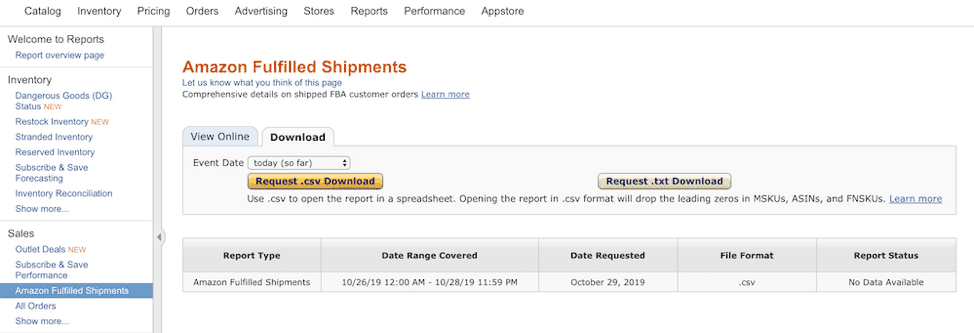
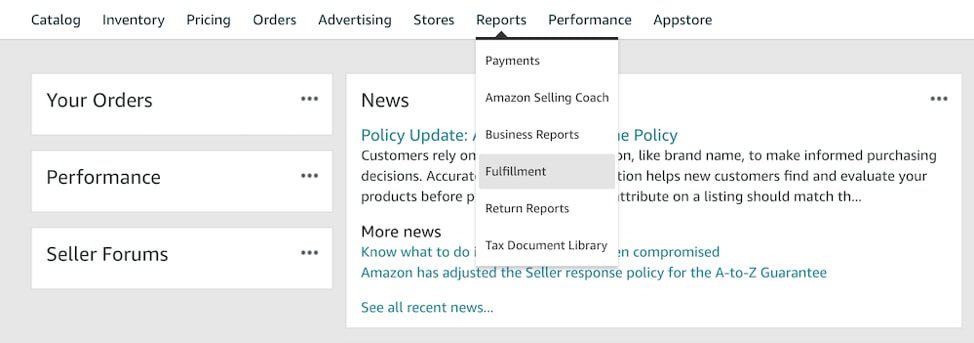
If you’re fulfilling your own orders (rather than selling FBA), you’ll want to go to the “Orders” heading, then “Order Reports”.

Whichever method you’re using, choose the time frame you want, and download the report. Delete the columns you don’t need, and upload the details mentioned above to Facebook to create your custom audience.
It should be noted that Amazon appears to be phasing out access to these customer details. They recently cut off access to buyers’ names via their API, and some sellers have mentioned in Amazon communities difficulty accessing historic order data. It’s a good idea to periodically export this data while you can, just in case Amazon cuts it off for good at some point.
Method Two: Pixel Data from a Landing Page or Website
This Amazon customer data is a great start if you don’t have any assets at all. But it’s not going to be totally accurate.
It’s better if you have Facebook Pixel data. This will give you actual Facebook profiles (for targeting purposes) of your leads, and much more info on their past actions, for you to target accordingly.
For example, you may have data from the Facebook Pixel on people who have viewed a product, but not purchased. This is a great way to build audiences for retargeting ads, pushing people who are on the fence to finally buy.
Since the Pixel needs to be embedded in the base code of the site you want to track events on, you, unfortunately, can’t track these events on Amazon. The best way to gather data with the Facebook Pixel is either selling on your own store (with Shopify, for example) or sending outside traffic to Amazon through a landing page, where you can embed a pixel and track events.
Method Three: Capture Emails
Sending people to Amazon through a landing page funnel allows you to collect data with the Facebook Pixel… but why stop there? One of the most powerful assets you can have as an online business is an email list.
To start, with an email list you can build custom audiences (and by extension, lookalike audiences). Just upload your list in the “Audiences” tab in Facebook Ads Manager, and Facebook will create an audience from the emails they’re able to match to profiles.
This won’t have a 100% match rate, since not everyone has Facebook, or uses the same email across the board. But it will be pretty damn close.
The advantage of building audiences from your email list is that these leads are somewhat qualified already. People don’t give over their email address lightly, so if they’re on your list, you can be fairly sure they’re part of your target market.
Not many sellers have an email list, so it’s a good idea to start building one ASAP. The best way to do this is to set up a Facebook Ads – Amazon funnel, with a landing page in between.

You’ll use the landing page to offer a discount code in exchange for email options.
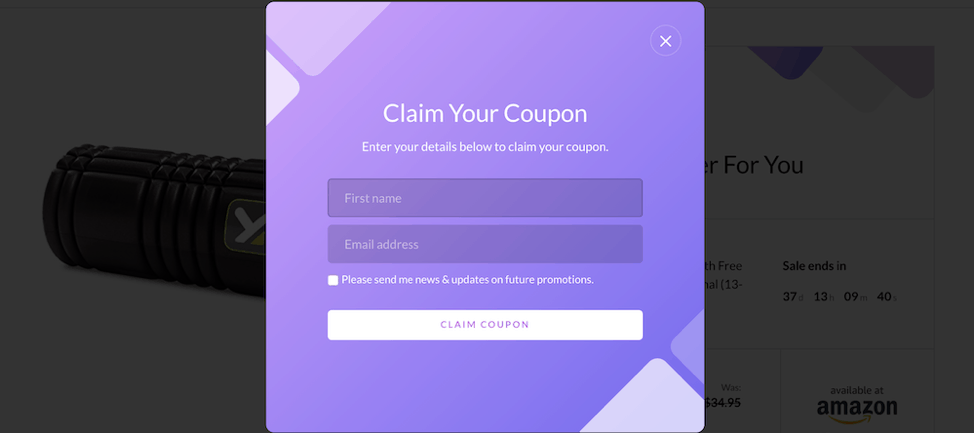
This funnel is not only a great incentive for people to give over their email address, but it’s also a way to drive additional sales to your product, increasing your BSR and keyword rankings.
Method Four: Drive Traffic Through ManyChat Flows
Facebook Messenger (and ManyChat) is quickly becoming the most popular way for sellers to send traffic to Amazon.
Messenger funnels give you many of the same advantages that landing pages do. They help qualify your leads before you send them to Amazon while giving you the opportunity to capture contact info and retargeting assets.
But Messenger is a much lower-friction option, which is why sellers are loving it. Keeping your funnel within the Facebook ecosystem allows you to engage your customers better, and acquire leads much cheaper than the alternatives.
Like previous funnels, you’ll want to set up ad campaigns to a Messenger bot sequence. Here, you can offer a discount code or rebate and qualify leads, before sending them through to Amazon.
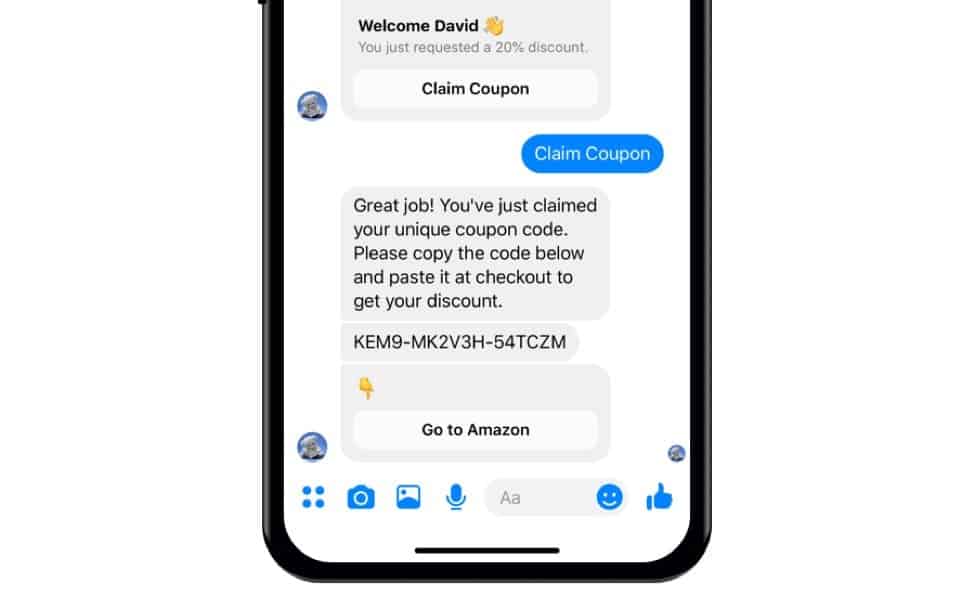
Run your ads for a while and build up a list of leads, then you can create an audience out of the people who interacted with your Messenger bot.
You can set up your Messenger flows yourself with ManyChat, or use LandingCube’s pre-built Facebook-to-Amazon sequences to get your funnel up and running in minutes.
Method Five: Cold Audience Targeting
Generally speaking, cold audience targeting is the least effective type of audience. But if you don’t have any assets in place to build custom and lookalike audiences, you’ll need to start somewhere.
Cold audiences can still be effective, and in some cases will outperform lookalike audiences. But it takes a lot more work to get them right.
A good tip when targeting cold audiences is to include “Amazon.com” as an interest, and the “Engaged Shoppers” behavior. Then use 1-2 interests related to your product or niche on top of that. Make sure to place each interest or behavior separately, so it reads “and” – meaning your ads will only show to people who meet all criteria (not just one or two).
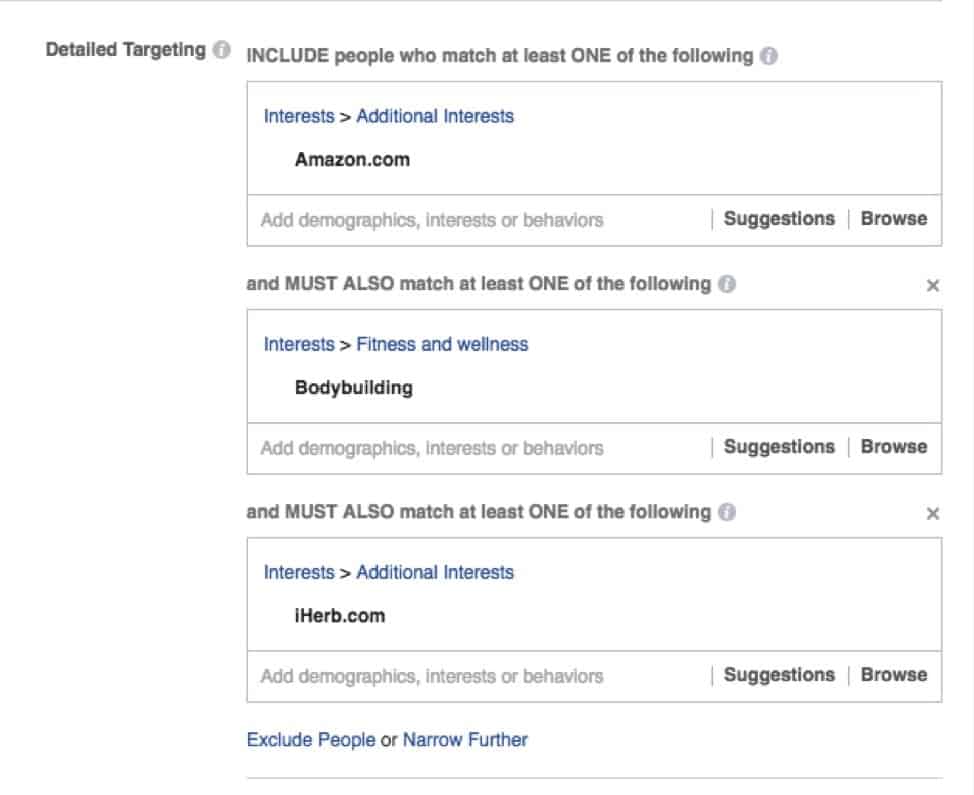
The most important thing with cold audiences is to keep testing. Run different audiences against each other, differing only in interests. You’ll find some that outperform the rest. Stick with those, and continue to iterate to bring down your cost per lead.
Layering & Testing Audiences
The beauty of Facebook Ads is how specific you can get with audience targeting. You don’t need to stop at a lookalike audience based on your email list. You can go ahead and layer additional interests on top of your lookalike audience to build an even more targeted audience.
It might seem counterintuitive to cut down your audience size, as you’ll have the possibility of reaching fewer people. But the more targeted your audience, the cheaper your ads will be.
This study put a broad audience against a targeted lookalike audience. While the broad audience had a potential reach of 170 million Facebook users, it resulted in 3.75 times higher cost per conversion – significantly fewer leads for the same ad spend.
So, it benefits you to use detailed targeting, and narrow your audience down as much as you can (within reason – you probably don’t want to end up showing ads to only 10 people).
The other thing that will help you tremendously is testing. All marketers test extensively, and this is doubly important for audience targeting. It’s the only way you’ll land on the audiences that work the best.
Some things you can test include:
- Location
- Age
- Gender
- Interests
- Behaviors
- Lookalike size
When testing, you want to keep most factors the same, only changing one factor. When you test an audience, make sure you’re running the same copy and creative, and your audiences are the same outside of the variable being tested.
For example, you might run an ad with a 1% lookalike vs a 2% lookalike. Or a cold audience where the detailed targeting (interests & behaviors) are the same, but the location/age/gender differs.
Facebook Audience Building for Amazon Sellers: In Summary
More and more Amazon sellers today are looking to external traffic to grow their business, specifically Facebook Ads.
Facebook Ads give you a whole new audience to put your products in front of, with less restriction and competition that sellers have to contend with on Amazon.
In order to start running Facebook Ads profitably, you need to get your targeting right. And by using the steps outlined above to build Facebook audiences, your business will be able to start benefiting from Facebook Ads sooner, rather than later.
Author:

Andrew Buck is the Head of Marketing and Customer Success at LandingCube, a suit of tools to help Amazon sellers market their products in external traffic channels. Andrew and the team at LandingCube are passionate about building software tools that help online stores grow their brand, and build a path to long-term success on (and off) Amazon.



